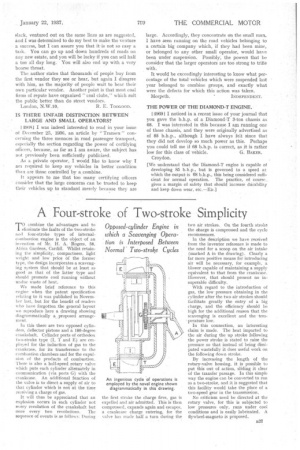A Four-stroke of Two-stroke Simplicity
Page 47

If you've noticed an error in this article please click here to report it so we can fix it.
er0 combine the advantages and to
eliniinate the faults of the two-stroke and fourLstroke types of internalcombustion engine is the object of an invention of Mr: H. A. .Rogers, 58, Africa Gardens, Cardiff. Whilst retaining, the simplieity, compactness, light weight and low price of the former type, the design incorporates a scavenging system that should be at least as good as that of the latter type and should promote cool running without undue waste of heat.
We made brief reference to this engine when the patent specification relating to it was published in November last, but for the benefit of readers who have forgotten the general layout we reproduce here a drawing showing diagrammatically a..proposed arrangement.
In this there are two opposed. cylinders, deflector pistons and a 180-degree crankshaft. Cylinder. ports of orthodox two-stroke type (I, T and E) are employed for the induction of gas to the crankcase, for its transference to the combustion chambers and for the expulsion of the products of combustion. There is also a half-speed rotary valve which puts each cylinder alternately in communication (via ports G) with the crankcase. An additional function of the valve is to direct a supply of air to that cylinder which is not at the time receiving a charge of gas.
It will thus be appreciated that an explosion occurs in each cylinder not every revolution of the crankshaft but once every two revolutions. The sequence of events is as follows: During the first stroke the charge fires, gas is expelled and air admitted. This is then compressed, expands again and escapes, a crankcase charge entering, for the valve has made half a turn during the
two a,ir strokes. On, the fourth stroke the charge is compressed and the cycle recommences.
In the description we have received from the inventor reference is made to the need for a scoop on the air intake (marked A in the drawing). Clearly a far more positive means for introducing air will be necessary, for example, a blower capable of maintaining a supply equivalent to that from the crankcase. However, that should present no insuperable difficulty.
With regard to the introduction of gas, the low pressure obtaining in the cylinder after the two air strokes should facilitate greatly the entry of a big charge, and the efficiency should be high for the additional reason that the scavenging is excellent and the • temperature low.
In this connection, an interesting claim is made. The heat imparted to the air during the up stroke following the power stroke is stated to raise the pressure so that instead of being dissipated wastefully it does useful work on the following down stroke.
By increasing the length of the rotary-valve housing, it is possible to put this out of action, sliding it clear of the transfer passage. In this simple way the engine can be converted to run as a two-stroke, and it is suggested that this facility would take the place of a two-speed gear in the transmission, No criticism need be directed at the rotary valve, for this is subjected to low, pressures only, runs under cool conditions and is easily lubricated. A flywheel-magneto is proposed.
















































































































